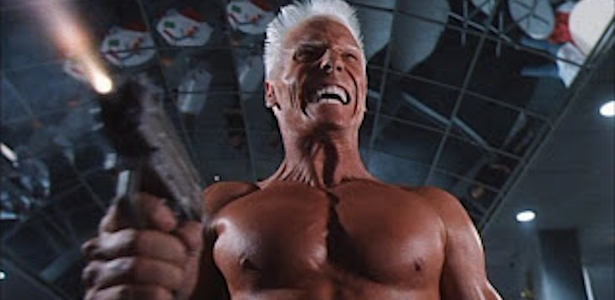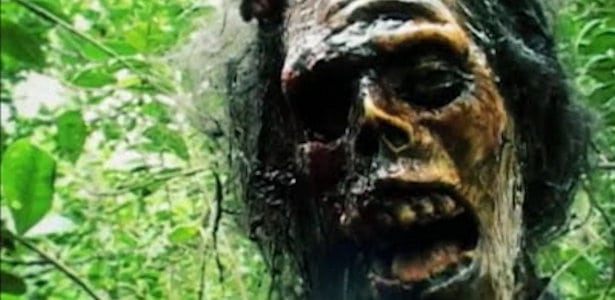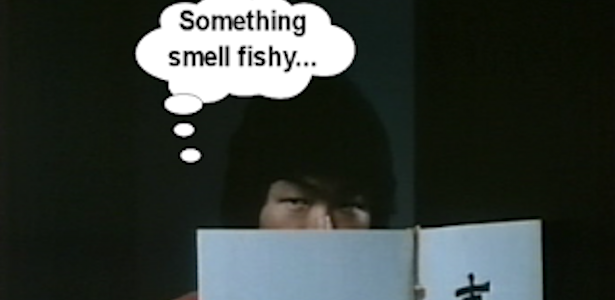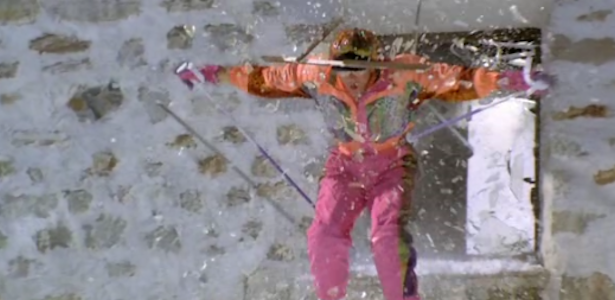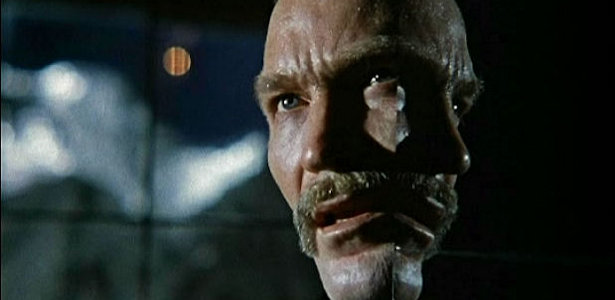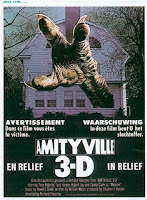 There has been little debate over what exactly caused the extinction of the newly reborn 3-D film in the ‘80s. Some claim it was fussy people who didn't want to put on glasses to see a movie; others point the finger squarely at cheap filmmaking with poorly realized 3-D effects. FRIDAY THE 13th PART III is a film that in spite of the fact that it did solid box office and is well liked among fans, it is unfortunately without a doubt one of the movies that brought about a heartbreaking death of 3-D cinema in the '80s.
There has been little debate over what exactly caused the extinction of the newly reborn 3-D film in the ‘80s. Some claim it was fussy people who didn't want to put on glasses to see a movie; others point the finger squarely at cheap filmmaking with poorly realized 3-D effects. FRIDAY THE 13th PART III is a film that in spite of the fact that it did solid box office and is well liked among fans, it is unfortunately without a doubt one of the movies that brought about a heartbreaking death of 3-D cinema in the '80s.Paramount and Universal, much like the dinosaurs, have always lead the pack in stogy resistance to anything new. They were the hold-out studios that refused to accept DVD as a new format back in the ‘90s. They called it a “fad” and insisted that it would die a quick consumer death, like Beta, but faster. After studios like Warner Brother’s who had quickly adopted the new format started seeing booming sales, only then did Paramount and Universal grudgingly adopt the new format, but flat out refused to release anything other than barebones theatrical releases. This attitude mirrors their feelings about exploitation films. Don’t get me wrong, they are more than happy to exploit their cash-cow franchises and I suppose they should be given credit for even sticking their crusty toe in the tri-dimensional waters, but their approach is cynical at best.


Like any Hollywood studio of the era, Universal and Paramount have a history of making sequels to their franchises. Unfortunately they seemed to have little faith in them. Even accounting for the law of diminishing returns, many of their sequels have been on the whole low budget and indifferently executed, or even just completely out of touch with audiences. Paramount's STAR TREK IV: THE VOYAGE HOME (1986) is a good example of the latter. Stuck in their backward thinking, didn’t put the money or the effort into these sequels and then made the logic leap to the inescapable conclusion that there’s no money to be made in doing them. The classic self-fulfilling prophecy. I firmly believe that Universal had no idea that PSYCHO II (1983) would be anything more than a cheap way to cash in on one of their old library titles, and expected it to be as memorable as your last meal at McDonalds.
 The summer of 1982 saw the release of the film that really kicked off the 3-D revival. Charles Band’s indy flick PARASITE (1982) hit screens in March causing a lot of commotion, but in August, Paramount unloaded the marketing machine for their milestone 3-D flick, FRIDAY THE 13th PART III (1982). This was first big studio 3-D movie in over 25 years (last one being Universal's REVENGE OF THE CREATURE in 1955), and it turned into the second highest grossing 3-D movie ever made until JAWS 3-D (1983) came out the following summer. For something so seminal to an era and indelibly marked in pop culture, it is amazing how low-rent and shoddy this film really is. Because it was such a draw, it brought in a lot of people who were interested in seeing a 3-D film from a big studio, and a high-profile film like FRIDAY THE 13th PART III did just that. Got asses in seats that may not have been there otherwise. JAWS 3-D (1983) managed to do this also, and it is because of the sloppy, careless attitudes of these two studios that turned off a major portion of the movie-going population, leaving only the hard-core fans to throw-down the ducats. Any studio will tell you straight-up, they aren't in it for the hard-core fans. They don't want to appeal to you (I'm assuming you are as crazy as us), they want your neighbors and co-workers.
The summer of 1982 saw the release of the film that really kicked off the 3-D revival. Charles Band’s indy flick PARASITE (1982) hit screens in March causing a lot of commotion, but in August, Paramount unloaded the marketing machine for their milestone 3-D flick, FRIDAY THE 13th PART III (1982). This was first big studio 3-D movie in over 25 years (last one being Universal's REVENGE OF THE CREATURE in 1955), and it turned into the second highest grossing 3-D movie ever made until JAWS 3-D (1983) came out the following summer. For something so seminal to an era and indelibly marked in pop culture, it is amazing how low-rent and shoddy this film really is. Because it was such a draw, it brought in a lot of people who were interested in seeing a 3-D film from a big studio, and a high-profile film like FRIDAY THE 13th PART III did just that. Got asses in seats that may not have been there otherwise. JAWS 3-D (1983) managed to do this also, and it is because of the sloppy, careless attitudes of these two studios that turned off a major portion of the movie-going population, leaving only the hard-core fans to throw-down the ducats. Any studio will tell you straight-up, they aren't in it for the hard-core fans. They don't want to appeal to you (I'm assuming you are as crazy as us), they want your neighbors and co-workers.I have a real soft spot of this movie, but let’s be honest here, it's pretty cheap, even by the inexpensive nature of the franchise, or the genre, itself. It also abandons the "realistic" characters of the first two films and creates more of a comicbook world with a wannabe Tommy Chong and an absurdly cartoonish biker "gang" that consists of two dudes and a chica. It also features a classy white girl, who we are supposed to view as a ghetto Latina. "We don't take no food stamps!" It also slams the "annoying funnyguy" character into overdrive and gives us Shelly (Larry Zerner), the most pathetic and annoying loser of the entire franchise. In spite of this goofy approach to the material, it was the movie that really solidified the slasher film as a genre in the ‘80s, made the hockey mask an icon and hell, it was in 3-D! Yes, as much as I bitch about the relentlessly bad choices of things to shove in the face of the audience, I still get a kick out of it.
With only a handful of shooting locations, most of them being studio sets, you’d think they might be able to muster some claustrophobic atmosphere, but Steve Miner was unfortunately constrained by a tight shooting schedule and the difficulty of working in the 3D format. Shooting in 3D often meant an obscene amount of takes had to be done, the lighting had to be bright, and the actors had to hit their marks exactly. While the use of a new 3D lens made it possible for Miner to get some good movement out of the camera, some aspects of the production slipped.
 At times Miner and company almost seem to be more interested in making a virtually sex and nudity-free sequel to PORKY’S (1982) rather than a sequel to his own dark and gritty FRIDAY THE 13th PART 2 (1981). The movie features two scenes of guys getting attacked while in toilets, hippies who smoke so much weed their van appears to be on fire, a dude who looks like Scott Baio, a snarky sex-pot, and a chubby Jewish kid that just wants to be liked to the point where the audience is ready to kill his annoying ass after his very first scene. And let's not forget the "farmboy" character, who talks like a city guy and not only wears a sweater, but wears a sweater around his neck like some sort of Eurotrash dude! Show up for work on any farm in the US and you will either be laughed out of the county or shot at, one of the two. The movie seems to be plotted in a way to go from one 3-D gag to another, which would be fine if the 3-D gags were even somewhat horror-ish. Instead we get yo-yo’s (which, I’ll admit, did make me flinch), apples, popcorn, joints, wallets, baseball bats, bales of hay, swinging ropes, etc. We do end up with the classic "eye popping" gag in addition to the really effective scene in which Andy (Jeffrey Rogers) looks up while walking on his hands to see Jason swinging a machete straight down between his legs. A scene that deeply disturbed me at the time. Actually, even with the lack of censorship in today's films, it's still an "instant clench" scene.
At times Miner and company almost seem to be more interested in making a virtually sex and nudity-free sequel to PORKY’S (1982) rather than a sequel to his own dark and gritty FRIDAY THE 13th PART 2 (1981). The movie features two scenes of guys getting attacked while in toilets, hippies who smoke so much weed their van appears to be on fire, a dude who looks like Scott Baio, a snarky sex-pot, and a chubby Jewish kid that just wants to be liked to the point where the audience is ready to kill his annoying ass after his very first scene. And let's not forget the "farmboy" character, who talks like a city guy and not only wears a sweater, but wears a sweater around his neck like some sort of Eurotrash dude! Show up for work on any farm in the US and you will either be laughed out of the county or shot at, one of the two. The movie seems to be plotted in a way to go from one 3-D gag to another, which would be fine if the 3-D gags were even somewhat horror-ish. Instead we get yo-yo’s (which, I’ll admit, did make me flinch), apples, popcorn, joints, wallets, baseball bats, bales of hay, swinging ropes, etc. We do end up with the classic "eye popping" gag in addition to the really effective scene in which Andy (Jeffrey Rogers) looks up while walking on his hands to see Jason swinging a machete straight down between his legs. A scene that deeply disturbed me at the time. Actually, even with the lack of censorship in today's films, it's still an "instant clench" scene. There are many films of the era that rely on stupidly conceived 3-D gags (such as 1983 AMITYVILLE 3-D’s long sequence in which a boom mic is slowly pushed into the audience), but for some reason the gags here wears thinner than most. Even AMITYVILLE 3-D had more going on in the first hour; John Harkins (Rush Limbaugh and John Quaid’s lovechild) chokes to death on evil, kamikaze flies fer cryin’ out loud. Here there is no Crazy Ralph character per se, just a crazy coot who is only in the beginning of the film due to studio edits, not really much of anything to whet the appetite except the presumably sit-comish white trash couple that provide more character annoyance, a cheap scare (a cameo from the white mouse in 1975s WILDCAT WOMEN), and a couple of mediocre kills that could be from any random '80s slasher. Why is it I can see a teenage Rob Cummings (aka Zombie) sitting in the theater thinking that this was the best part? "Lookit the white trash people! They are so, like, white and trashy!"
There are many films of the era that rely on stupidly conceived 3-D gags (such as 1983 AMITYVILLE 3-D’s long sequence in which a boom mic is slowly pushed into the audience), but for some reason the gags here wears thinner than most. Even AMITYVILLE 3-D had more going on in the first hour; John Harkins (Rush Limbaugh and John Quaid’s lovechild) chokes to death on evil, kamikaze flies fer cryin’ out loud. Here there is no Crazy Ralph character per se, just a crazy coot who is only in the beginning of the film due to studio edits, not really much of anything to whet the appetite except the presumably sit-comish white trash couple that provide more character annoyance, a cheap scare (a cameo from the white mouse in 1975s WILDCAT WOMEN), and a couple of mediocre kills that could be from any random '80s slasher. Why is it I can see a teenage Rob Cummings (aka Zombie) sitting in the theater thinking that this was the best part? "Lookit the white trash people! They are so, like, white and trashy!" I can see a Paramount exec in a script meeting saying “who cares? The kind of people who go to see this will either be stoned or screwing in the back seat of their parent’s station wagon. Just get it done so we can shoot it!” The final 20 minutes is where this movie really musters up some iconic moments that will serve the series well for years to come. The scene where Jason, hanging from a noose, opens his eyes, lifts himself up, pulling the noose off and accidentally removing his mask to reveal his twisted fact, before quickly sliding it back on and dropping to the ground is a classic that never gets old. The scene where Jason takes an axe in the head and then raises his arms appearing to lunge right into the audience is without question a defining moment, not just in the series, but in cinema pop culture the world over. There are some other great moments as well, including Harry Manfredini’s notorious “disco” re-envisioning of the original score and the cheesy, but effective eye-popping scene, and the sadly edited split-torso bit, which keep me coming back and make me wistfully nostalgic of an entry that is book-ended by better films.
I can see a Paramount exec in a script meeting saying “who cares? The kind of people who go to see this will either be stoned or screwing in the back seat of their parent’s station wagon. Just get it done so we can shoot it!” The final 20 minutes is where this movie really musters up some iconic moments that will serve the series well for years to come. The scene where Jason, hanging from a noose, opens his eyes, lifts himself up, pulling the noose off and accidentally removing his mask to reveal his twisted fact, before quickly sliding it back on and dropping to the ground is a classic that never gets old. The scene where Jason takes an axe in the head and then raises his arms appearing to lunge right into the audience is without question a defining moment, not just in the series, but in cinema pop culture the world over. There are some other great moments as well, including Harry Manfredini’s notorious “disco” re-envisioning of the original score and the cheesy, but effective eye-popping scene, and the sadly edited split-torso bit, which keep me coming back and make me wistfully nostalgic of an entry that is book-ended by better films.I give Paramount a bit more leniency than Universal as they actually come around and realize that sequels don’t necessarily need to be completely budget starved. FRIDAY THE 13th PART V: A NEW BEGINNING (1985) fumbled the ball by offering a cheap, scattershot and ill-conceived cash-in that did great the opening weekend, because nobody knew they were going to see what was essentially a side-story. After taking a lot of flack from fans (and, of course, critics) they got their heads screwed on straight and laid out a significantly improved budget for a solid cast and great premise that completely brought the series back to life (so to speak) with FRIDAY THE 13th PART VI: JASON LIVES (1986), though in fairness, it wasn’t as successful at the box office. I remember there being a sense of lingering resentment from friends and acquaintances (which to my mind means all audiences) who felt they had been duped the last time. Paramount may may be slightly better than Universal, but when it came to screwing up in 3-D, they decimated the competition. A month after the release of JAWS 3-D, Paramount released their true 3-D killer, THE MAN WHO WASN’T THERE (1983).




